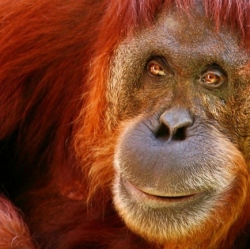
The Eastern Gorilla, the largest living primate, has been listed as Critically Endangered due to illegal hunting, according to the IUCN Red List of Threatened Species released at the IUCN World Conservation Congress taking place in Hawaii. Four out of six great ape species are now Critically Endangered.
Today’s IUCN Red List update also reports the decline of the Plains Zebra due to illegal hunting, and the growing extinction threat to Hawaiian plants posed by invasive species. Thirty eight of the 415 endemic Hawaiian plant species assessed for this update are listed as Extinct and four other species have been listed as Extinct in the Wild, meaning they only occur in cultivation. The IUCN Red List now includes 82,954 species of which 23,928 are threatened with extinction.
The Eastern Gorilla (Gorilla beringei), which is made up of two subspecies, has moved from Endangered to Critically Endangered due to a devastating population decline of more than 70% in 20 years. Its population is now estimated to be fewer than 5,000. Grauer’s Gorilla (G. b. graueri), one subspecies of Eastern Gorilla, has lost 77% of its population since 1994, declining from 16,900 individuals to just 3,800 in 2015.
Killing or capture of great apes is illegal; yet hunting represents the greatest threat to Grauer’s Gorillas. The second subspecies of Eastern Gorilla, the Mountain Gorilla (G. b. beringei) -is faring better and has increased in number to around 880 individuals. Four of the six great apes, Eastern Gorilla, Western Gorilla, Bornean Orangutan and Sumatran Orangutan, are now listed as Critically Endangered, whilst the Chimpanzee and Bonobo are listed as Endangered.
"To see the Eastern gorilla, one of our closest cousins, slide towards extinction is truly distressing," says Inger Andersen, IUCN Director General. "We live in a time of tremendous change and each IUCN Red List update makes us realize just how quickly the global extinction crisis is escalating. Conservation action does work and we have increasing evidence of it. It is our responsibility to enhance our efforts to turn the tide and protect the future of our planet."
The once widespread and abundant Plains Zebra (Equus quagga) has moved from Least Concern to Near Threatened. The population has reduced by 24% in the past 14 years from around 660,000 to a current estimate of just over 500,000 animals. In many countries Plains Zebra are only found in protected areas, yet population reductions have been recorded in 10 out of the 17 range states since 1992. The Plains Zebra is threatened by hunting for bushmeat and skins, especially when they move out of protected areas.
Three species of antelope found in Africa — Bay Duiker (Cephalophus dorsalis), White-bellied Duiker (Cephalophus leucogaster) and Yellow-backed Duiker (Cephalophus silvicultor) — have moved from Least Concern to Near Threatened. Whilst the populations of these species within protected areas are relatively stable, those found in other areas are decreasing due to continued illegal hunting and habitat loss.
"Illegal hunting and habitat loss are still major threats driving many mammal species towards extinction," says Carlo Rondinini, Coordinator of the mammal assessment at Sapienza University of Rome "We have now reassessed nearly half of all mammals. While there are some successes to celebrate, this new data must act as a beacon to guide the conservation of those species which continue to be under threat."
Hawaiian plants threatened by Invasive species such as pigs, goats, rats, slugs, and non-native plants are destroying the native flora in Hawai’i. The latest results show that of the 415 endemic Hawaiian plant species assessed so far for The IUCN Red List (out of ca. 1,093 endemic plant species), 87% are threatened with extinction, including the Endangered ‘Ohe kiko’ola (Polyscias waimeae) — a beautiful flowering tree found only on the island of Kauai.
Thirty Eight have been listed as Extinct, including the shrubs ‘Oha Wai (Cyanea eleeleensis) and Hibiscadelphus woodii. Four species have been listed as Extinct in the Wild including the Haha (Cyanea superba) last seen in the wild in 2003. Invasive species are the main threat to all of these species, with many being threatened by more than one invasive species. The IUCN Species Survival Commission (SSC) Hawaiian Plant Specialist Group anticipates the remaining species to be assessed will also be highly threatened.
"Hawaii is an example of nature at its best with spectacular examples of evolution, yet it is facing an uncertain future due to the impact of invasive species — showing how unwittingly, human actions can make nature turn against itself," says Matt Keir, a member of the IUCN SSC Hawaiian Plant Specialist Group. "What we see happening in Hawaii is foretelling what will happen in other island or contained ecological systems. Hawaii and other nations must take urgent action to stop the spread of invasive species and to protect species with small population sizes"
The Critically Endangered flowering Haha plant Cyanea remyi, is one of the 105 extremely rare Hawai’ian plant species on the Red List with less than 50 mature individuals. Alula (Brighamia insignis) has moved from Critically Endangered to Critically Endangered (Possibly Extinct in the Wild), and is one of 38 Red Listed species with less than five individuals remaining. The Alula has been so impacted by invasive species and landslides, that only one plant remained in the wild in 2014 and it has not been seen since.
This new data will be used to influence action such as listing species on the US Endangered Species Act which will assist in securing funding for conservation programs to target and control invasive species, and to fence wild areas to protect them from large mammals. Improved biosecurity to stop invasive species entering the country is essential, according to IUCN experts.
